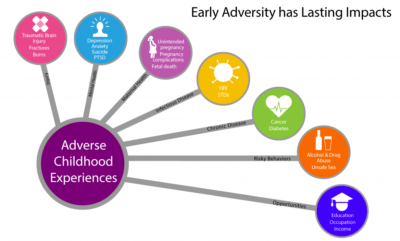The statistics are staggering.
67% of the population has had at least 1 traumatic event in their lifetime. Of that 67%, 16% have had at least 4 traumatic experiences in their life which is considered complex trauma.
67%.
Let that sink in.
If you were in a movie theater, it would be safe to assume that most of the people in the theater with you had experienced trauma. If you were a classroom teacher with a class size of 30, that would mean 20 of your students had experienced trauma.
We know the facts. Trauma changes the brain. It changes the way someone looks at the world, reacts to challenges, and their ability to cope with various situations. It can even lead to early death.

Photo courtesy of www.cdc.gov
It’s hard to believe, isn’t it? All these hurt people walking around. Some of them don’t even LOOK like they have trauma. For most of us, trauma is something we hide deep, deep down. It is not a sign we walk around holding, and we certainly don’t shout it from the rooftops.
At Bithiah’s, we teach Universal Precautions. We don’t know who has experienced trauma so we are going to treat EVERYONE as if they’ve experienced it.
Think about it. If you were driving on the freeway and a car cut you off, nearly crashing into you, your reaction would most likely be anger. You would want to honk, yell, or even curse at the car. Now, imagine that same car had a sign on the back of it that read, “I am SO sorry for my erratic driving, I just got a call that my child is hurt and I am racing to the hospital.” Your reaction would be much different. You would give grace, feel empathy, possibly even say a prayer for that person. This is how practicing Universal Precautions works. Just to be safe, we are going to assume the worst.
This is not an uncommon practice. In hospitals, Universal Precautions are practiced daily. As part of infection control, all human blood is treated as if it contains bloodborne pathogens. This mean that gloves are worn, hands are washed, and clean up is done correctly.
In regards to trauma, this means extra grace is given, second chances are the norm and the conversation shifts from- “What’s wrong with them?” to “What happened to them?”.
Can you imagine what life would look like if everyone practiced this? If interactions with customers, students, children and everyone else was filtered through this lens, wouldn’t life be so different?
What if we just assumed the worst?
